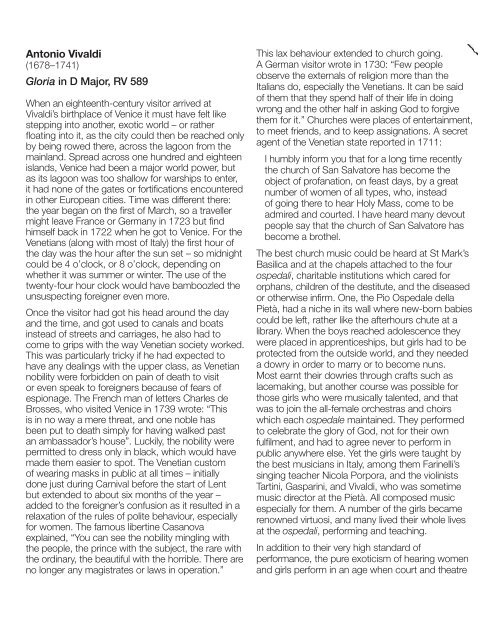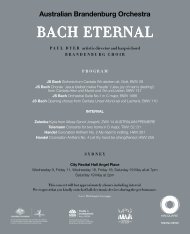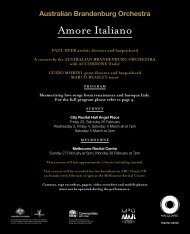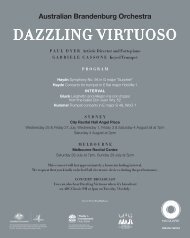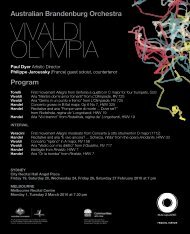download PDF program - Australian Brandenburg Orchestra
download PDF program - Australian Brandenburg Orchestra
download PDF program - Australian Brandenburg Orchestra
Create successful ePaper yourself
Turn your PDF publications into a flip-book with our unique Google optimized e-Paper software.
Antonio Vivaldi<br />
(1678–1741)<br />
Gloria in D Major, RV 589<br />
When an eighteenth-century visitor arrived at<br />
Vivaldi’s birthplace of Venice it must have felt like<br />
stepping into another, exotic world – or rather<br />
floating into it, as the city could then be reached only<br />
by being rowed there, across the lagoon from the<br />
mainland. Spread across one hundred and eighteen<br />
islands, Venice had been a major world power, but<br />
as its lagoon was too shallow for warships to enter,<br />
it had none of the gates or fortifications encountered<br />
in other European cities. Time was different there:<br />
the year began on the first of March, so a traveller<br />
might leave France or Germany in 1723 but find<br />
himself back in 1722 when he got to Venice. For the<br />
Venetians (along with most of Italy) the first hour of<br />
the day was the hour after the sun set – so midnight<br />
could be 4 o’clock, or 8 o’clock, depending on<br />
whether it was summer or winter. The use of the<br />
twenty-four hour clock would have bamboozled the<br />
unsuspecting foreigner even more.<br />
Once the visitor had got his head around the day<br />
and the time, and got used to canals and boats<br />
instead of streets and carriages, he also had to<br />
come to grips with the way Venetian society worked.<br />
This was particularly tricky if he had expected to<br />
have any dealings with the upper class, as Venetian<br />
nobility were forbidden on pain of death to visit<br />
or even speak to foreigners because of fears of<br />
espionage. The French man of letters Charles de<br />
Brosses, who visited Venice in 1739 wrote: “This<br />
is in no way a mere threat, and one noble has<br />
been put to death simply for having walked past<br />
an ambassador’s house”. Luckily, the nobility were<br />
permitted to dress only in black, which would have<br />
made them easier to spot. The Venetian custom<br />
of wearing masks in public at all times – initially<br />
done just during Carnival before the start of Lent<br />
but extended to about six months of the year –<br />
added to the foreigner’s confusion as it resulted in a<br />
relaxation of the rules of polite behaviour, especially<br />
for women. The famous libertine Casanova<br />
explained, “You can see the nobility mingling with<br />
the people, the prince with the subject, the rare with<br />
the ordinary, the beautiful with the horrible. There are<br />
no longer any magistrates or laws in operation.”<br />
This lax behaviour extended to church going.<br />
A German visitor wrote in 1730: “Few people<br />
observe the externals of religion more than the<br />
Italians do, especially the Venetians. It can be said<br />
of them that they spend half of their life in doing<br />
wrong and the other half in asking God to forgive<br />
them for it.” Churches were places of entertainment,<br />
to meet friends, and to keep assignations. A secret<br />
agent of the Venetian state reported in 1711:<br />
I humbly inform you that for a long time recently<br />
the church of San Salvatore has become the<br />
object of profanation, on feast days, by a great<br />
number of women of all types, who, instead<br />
of going there to hear Holy Mass, come to be<br />
admired and courted. I have heard many devout<br />
people say that the church of San Salvatore has<br />
become a brothel.<br />
The best church music could be heard at St Mark’s<br />
Basilica and at the chapels attached to the four<br />
ospedali, charitable institutions which cared for<br />
orphans, children of the destitute, and the diseased<br />
or otherwise infirm. One, the Pio Ospedale della<br />
Pietà, had a niche in its wall where new-born babies<br />
could be left, rather like the afterhours chute at a<br />
library. When the boys reached adolescence they<br />
were placed in apprenticeships, but girls had to be<br />
protected from the outside world, and they needed<br />
a dowry in order to marry or to become nuns.<br />
Most earnt their dowries through crafts such as<br />
lacemaking, but another course was possible for<br />
those girls who were musically talented, and that<br />
was to join the all-female orchestras and choirs<br />
which each ospedale maintained. They performed<br />
to celebrate the glory of God, not for their own<br />
fulfilment, and had to agree never to perform in<br />
public anywhere else. Yet the girls were taught by<br />
the best musicians in Italy, among them Farinelli’s<br />
singing teacher Nicola Porpora, and the violinists<br />
Tartini, Gasparini, and Vivaldi, who was sometime<br />
music director at the Pietà. All composed music<br />
especially for them. A number of the girls became<br />
renowned virtuosi, and many lived their whole lives<br />
at the ospedali, performing and teaching.<br />
In addition to their very high standard of<br />
performance, the pure exoticism of hearing women<br />
and girls perform in an age when court and theatre


